Schwäbisch-Alemannische-Fasnet written by Anna-Mae Geister 8a
My report is about the carnival in Ehingen. It’s very different from carnival in other countries and how other people know it. It begins on 11th November. On this day many people celebrate the start of the carnival for a long time. But it isn’t called carnival in Ehingen but `Fasnet´, it comes from the word `Fastnacht´, the time when some people don’t eat sugar, meat or whatever before Easter. Because of the very traditional carnival, Ehingen is also called `Kügeleshausen´, I’ll explain this later. The heart of the `Fasnet´ are the `Narren´. There are different groups of them, they are called `Narrenzunft´.
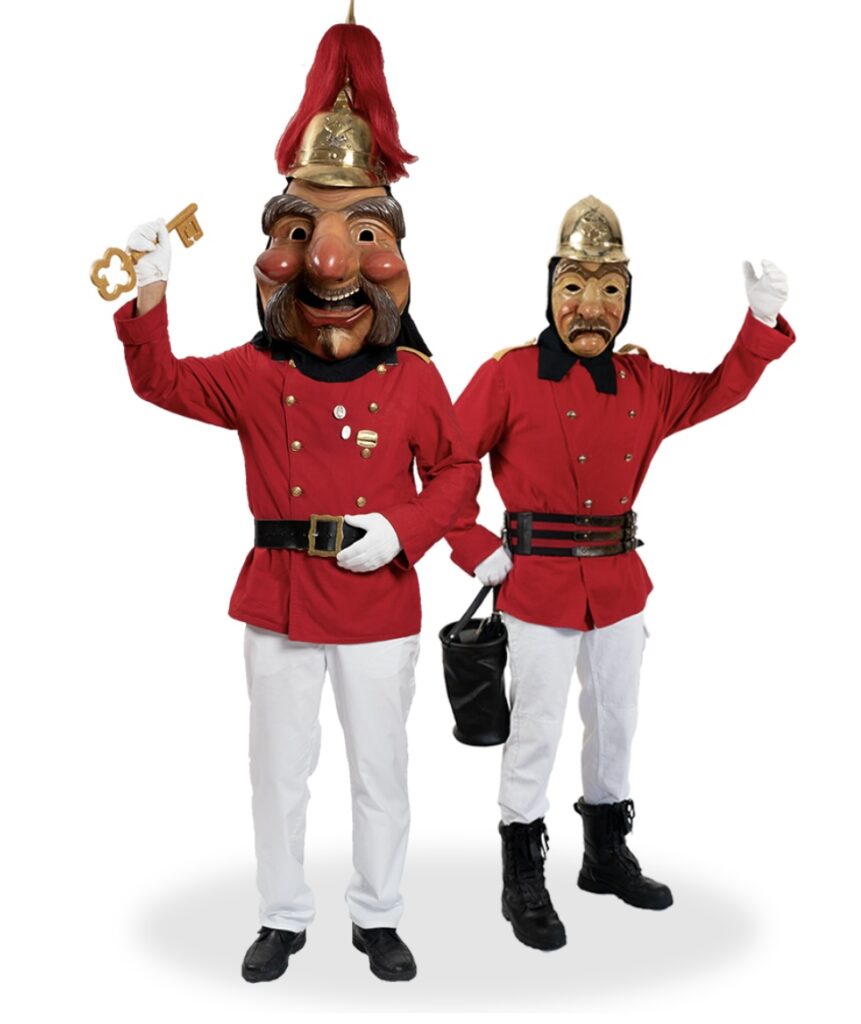
Muckenspritzer: Their leader is called `Spritzenmuck´, all of them wear a red jacket, white trousers, black boots and a golden helmet. Moreover, they have a wooden mask which looks like a normal face of a man but with a big nose, a moustache and long eyebrows. Their legend says, they were the firefighters, and they thought the steeple of the `Liebfrauen-Kirche´ in Ehingen burnt because they saw smoke around it. They began to fight the fire but suddenly a little child came and said the smoke are just mosquitoes. Since then their name has been `Muckenspritzer´. This story is also told in a song with the name `1850 so´. Their scream is ‘Mucken-Spritzer’.
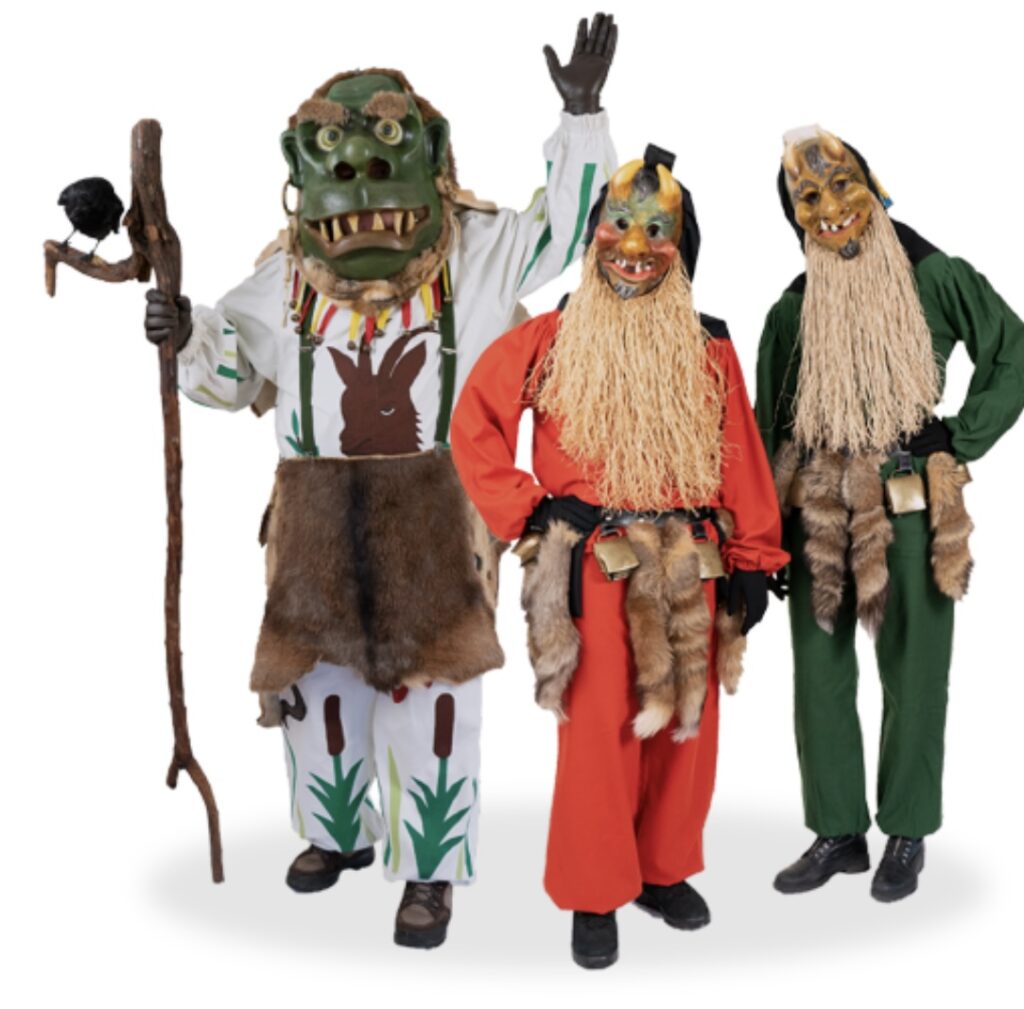
Dämonen: The demons’ leader is the `Groggentäler´, he also has the name `water demon (Wasserdämon)´and `swamp ghost (Sumpfgeist)´. He has a big green mask, a white costume with little water animals and grass on it and a coat out of goat skin and fur. By his side he has a frog and a goat and a stick with a raven. The story says, that he hunted in the `Groggental´ and ate humans and animals until someone killed him. The `Groggental´ and the `Groggensee´ were named after him. The `Dämonen´ wear a red or green costume, black shoes, a black belt with fox tails and bells on it. Some of them have a bone around their neck and a whip out of a cow tail. Their mask has horns and big teeth, a bit like a vampire, a beard out of hay and a cow tail over their head. Their scream is Groggen- Täler.
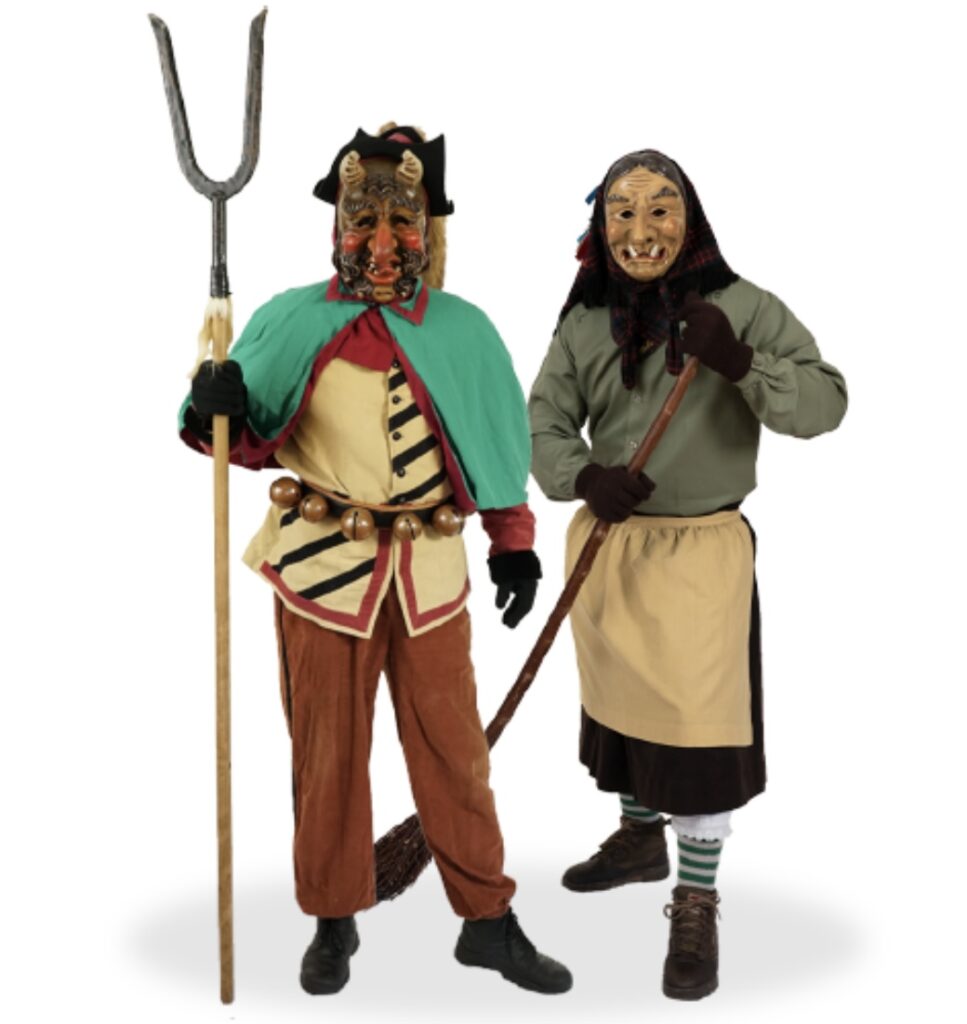
Wilde Weiber: They are witches and their leaders’ name is witch master, `Hexenmeister´ in German. He wears brown trousers, a light brown shirt, a belt with round bells around his tail and a green short jacket. His mask has also horns and a black moustache. At the top he wears a black hat with a fox tail. By his side is a stick too with a fork-like attachment. The witches themselves look different. Their costumes show the four seasons. A light green shirt shows summer, the brown skirt shows spring, the yellow pinny summer and the white trousers and the white-green curled socks show winter with prospects of spring. The mask looks like a real witch with black hair, a long nose and a disgusting wart. Some of them carry a broomstick. Their story comes from a woman named Katharina Schuster who lived in a cave and when she cooked you could see the smoke far away. The people said always `die Käther kocht wieder (the Käther is cooking again)´ and because of that, the cave was named `Käthra-Kuche´. And out of that their scream is Käthra-Kuche. This story you also find in a song.
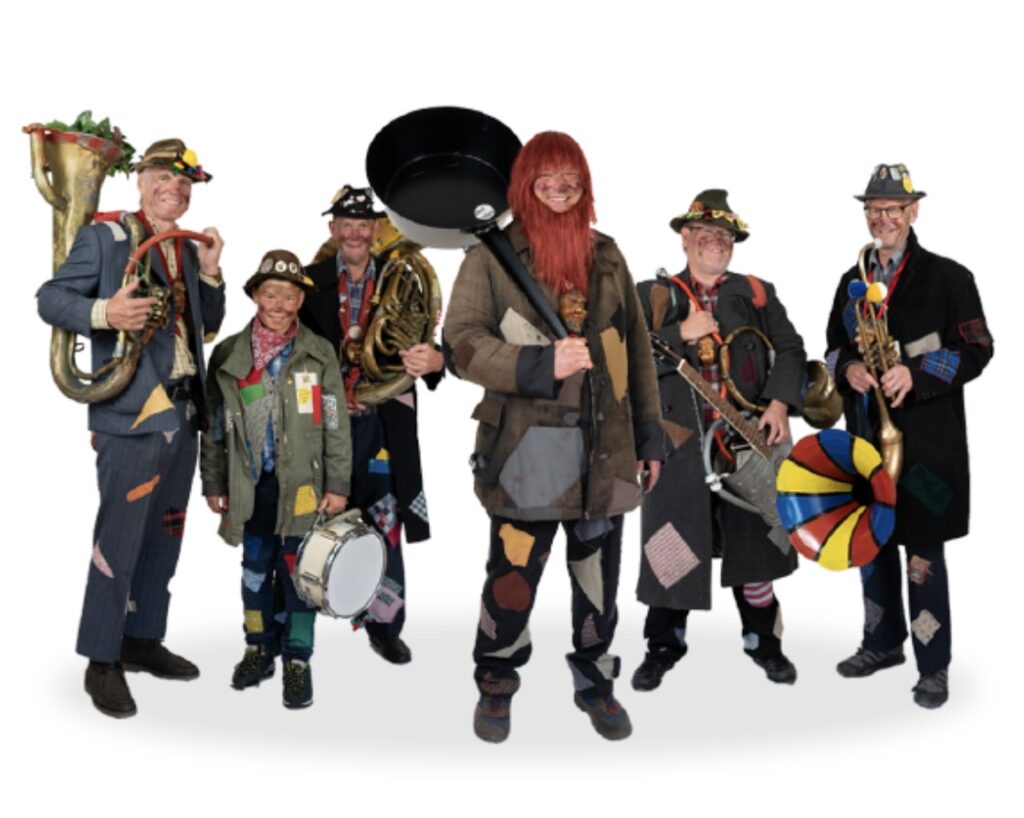
Mate-Kapelle: Their leaders’ name is `Pfannen-Mate´, the scream too. The `Pfannen-Mat´ has a red beard and red hair, what’s special about him is he doesn’t have instruments like the others but he has a pan with `Kügele´ and the pan has a hole. The costume from the whole band is grey with coloured sheets of other clothes. The `Pfannen-Mate´ has a nice story: he came from `Schlechtenfeld` and collected old iron to earn some money, with that money he bought `Kügele´ and presented them to children and poor people. This story and how it is today is told in the `Pfannen-Mate´-Song.
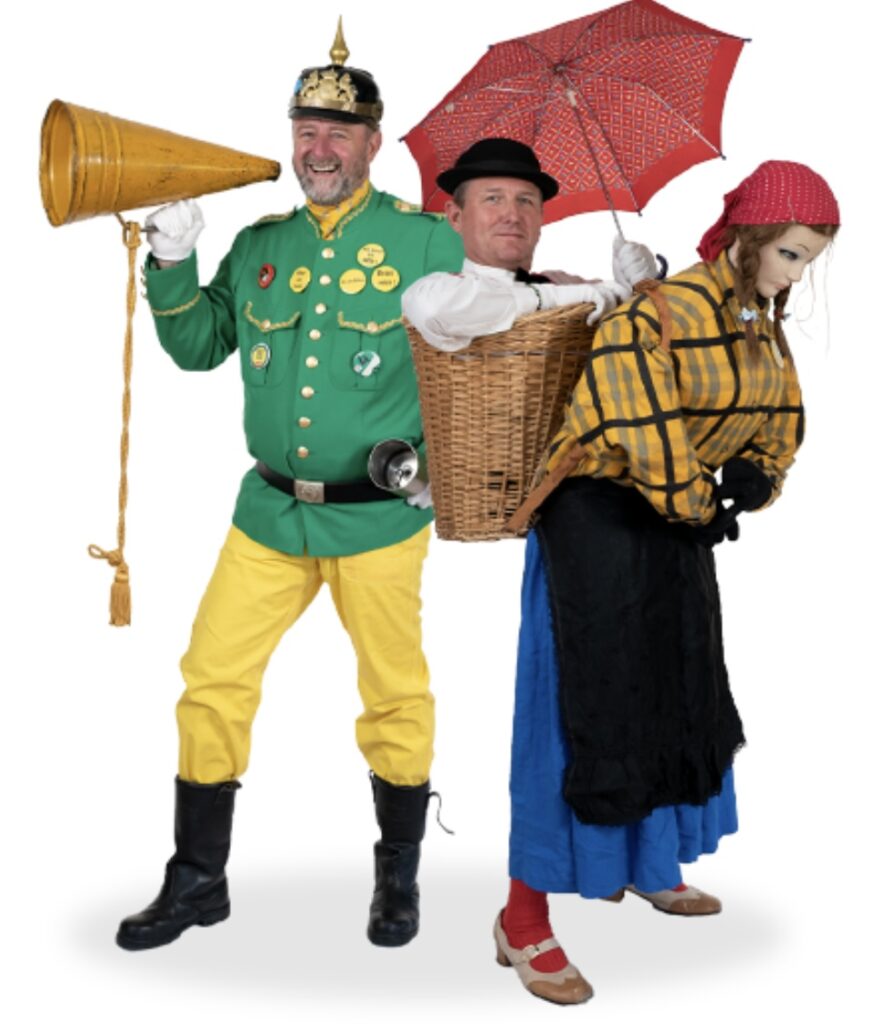
Büttel & Krettenweiber: They are a very funny group and make lot of jokes. They have two different costumes and the people change it from time to time. The `Büttel´ wear a green jacket, yellow trousers, a black helmet and they have a bell ring. They were the police earlier and their police cars are `Dixies´, you can see them still today, they are green and yellow too. The `Krettenweiber´ look very different, it looks like that men sit in baskets on the back of women. But the women are just puppets and the men’s legs are under the skirt. The puppets all look different, but the men wear a red jacket, a white shirt and a black hat. Their story is just, that earlier some men tried to climb into the baskets of their wives that they don’t have to walk. Because of the two different costumes they have two different screams: Kretten-Weiber and Narren-Büttel.
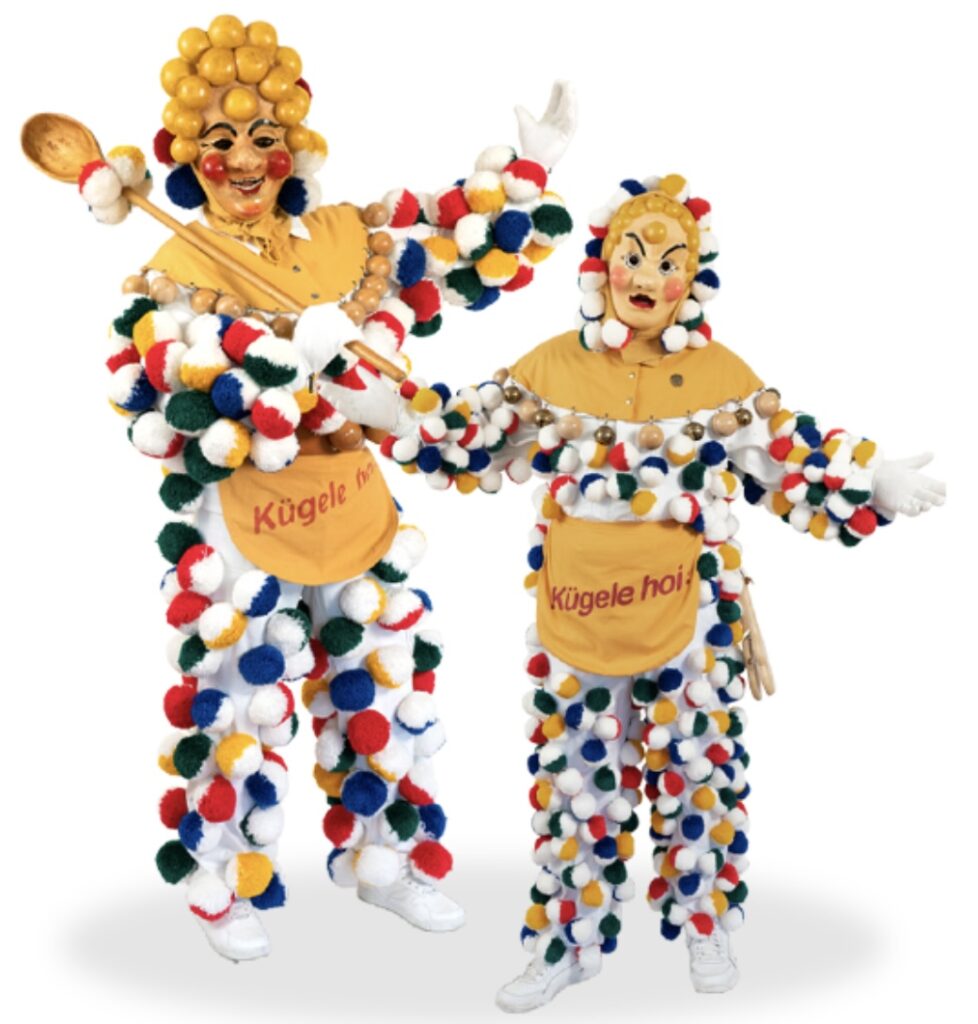
Kügele: The leader of them is called the `Große Kügele´ and it looks the same as the others. In my opinion they are the prettiest of all. They wear a white costume with coloured pompons of wool. The colours are red, blue, green and yellow but just the half of the pompons, the other is also white. The mask has also some but on the forehead and the hairline. They aren’t coloured but they are light brown like the same named tarts. The `Kügele´ have a yellow pinny too with the red line `Kügele-Hoi`, it’s also their scream. Moreover, they wear a `Goller´ is around the shoulders like a cape, on it are little bells and a big bitter wooden rattles. To support the balls and rattles, they have clappers in their hands. The `Kügele´ don’t have a story like the others. The tarts came from the `Pfannen-Mate´ and a man named Albert Maier asked himself why there’s no group with the name `Kügele´. So he founded them and created the costume, it should be a friendly mask in contrast to the witches and demons. This `Narrenzunft´ has even three songs, just a few years ago was texted a new one. From the `Kügele´ comes the name `Kügeleshausen´ because they represent the carnival.
Narrenrat: They are a few special people of the groups, the ringleaders, people in charge and other important people who worth being mentioned. They wear a grey hat and jacket, red cape, blue trousers and they have a red umbrella. You can recognize to which group they belong, because they have a little doll from their group sitting on their hat.
In the time of carnival there are around ten parades. There are some in other towns and cities, but the most important is on the `Glombigen´, the `Glombige´ is always a Thursday, because of that it’s called the `Glombige-Doschdig´. On this day the `Narren´ come into the schools and move them out. Midday is a performance for the children in the town hall. After this, there is a parade. In the evening it is the excavation of the `Groggentäler´ in the `Groggensee´ and a big firework. On the market square in Ehingen the `Kügele´ dance and the `Wilde Weiber´ jump through a fire, which is called the `Hexensprung´. Before they attack the city hall and throw the documents out of the windows. Then the mayor has to give the key of the town hall to the `Muckenspritzer´. On the Tuesday the next week is also a parade in Ehingen this day is the `Fasnetsdienstag´.
For the adults are another four events, four proms in the `Lindenhalle´. The first is the `Narrenball´, the second the `Bürgerball´, the third the `Nostalgieball` and the fourth the `Redoutt´. Everyone can come, but you need to be eighteen and for the last sixteen. There are programs and you can drink something.
The `Fasnet´ is a beautiful local event with its many different attractions and programs. I’m sure you will get some sweets when you visit it.
